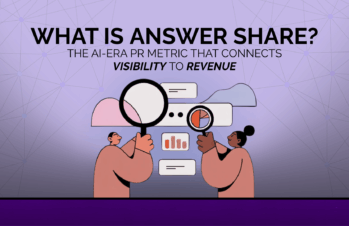Digital PR and traditional PR are like two sides of the same coin. They have the same goal — to increase brand visibility and reach — but they have different expressions. We believe PR agency are well served by both expressions, and we implement both traditional and digital strategies with our clients to ensure that exposure is maximized.
When it comes to developing a PR strategy, companies might face a decision between one of the two methods. So, which one is right for your B2B tech company? Let us break down the benefits and practices of both digital and traditional PR, and help guide you to the best PR strategy for your unique brand.
What is traditional PR?
Traditional PR is exactly what you’d think when you hear the words “public relations.” It focuses on coverage in formal publications like Forbes, Inc., the Wall Street Journal, and other online and offline publications…and so on. Traditional PR gets you press hits, which are usually driven by a single instance, event, or announcement.
What is digital PR?
Digital PR strategies are more comprehensive than traditional public relations campaigns. People want to feel connected to brands, so digital PR meets that need by providing a space for interaction. This can be anything from Tweet chats, to “ask me anything” (AMA) live events, being interviewed on podcasts, engaging in a Product Hunt campaign, live-streaming, and so on.
Keep Reading: How to Build a Successful B2B PR Strategy in 2021
What do traditional public relations look like in the wild?
Traditional PR is more formal than digital PR, so communications are packaged in different ways to various publications and journalists. From reaching out to a reporter with a Tweet to developing robust pitch packages submitted to publications for review and acceptance of the article, to answering HARO (help a reporter out) requests, traditional PR can take shape in many ways. The goal is to offer something new and exciting for the journalists to submit to their editors for approval.
Here’s a simple example: A B2B tech company is launching a new SaaS product. In traditional PR, pitch packages would be sent to targeted publications and media outlets in hopes that they would be picked up, written about, and therefore seen by a wider audience.
As a result, the new product would be mentioned in various publications, such as Forbes, Inc., TechCrunch, Wall Street Journal, etc. This would create visibility for the new product, building credibility for the tech company, and create momentum for the sales team in terms of leads.
What do digital public relations look like in the wild?
A digital PR strategy utilizes other digital outlets to interact, engage with, and create visibility and buzz for a brand to launch a product, announce new features, promote an event, announce new leadership, funding, M&A, etc.
Using that same example above, the B2B tech company launching a new SaaS product, a digital PR campaign might consist of a Product Hunt campaign, an Ask Me Anything LinkedIn Live event, or a tweet chat — or maybe even all three. This not only increases the visibility already created by the traditional PR campaign, but it also reaches new audiences and enables the brand to interact directly with its target audience.
Here’s a perfect real-life example:
For Kamua, an AI video editing software, we created a Product Hunt campaign to announce their new SaaS platform. There was a ton of preparation, as a PH campaign is not for the faint of heart. However, it was worth it! Kamua was recognized on Product Hunt as one of the top 3 “most hunted” products, and it had the most comments of the day!
The success of their Product Hunt campaign will go a long way in creating visibility among a targeted demographic on the PH platform, and with being a Top 3 Most Hunted Product, they have a badge they can now proudly display for all the world to see.
Traditional PR, Digital PR, or Both?
Traditional PR strategies work really well for events, product launches, mergers & acquisitions, leadership changes, or other major milestones. A write-up in a tech-focused online publication like Forbes, Inc., and trade publications, or being interviewed on a relevant podcast does wonders to create visibility, thought leadership, and fill your sales pipeline (if leveraged correctly).
You add even more power to the punch by layering on Digital PR to engage and interact more intimately with your audience through live streaming, Tweet chats, hosting an event on Clubhouse, having your product “hunted” through a Product Hunt campaign, etc.
How does Zen Media take public relations further?
We take a combined approach when it comes to PR. We don’t want to throw out the elements of traditional PR that are working, but we do want to build upon them for the digital age.
A combined digital and traditional PR strategy is successful with a team that not only knows how to reach the right members of the press when needed but also knows how to think outside the box to implement various digital campaigns to engage with a client’s audience. Combining traditional and digital effectively creates truly dramatic results that have a direct correlation to your bottom line.
Additionally, many public relations initiatives end when the brand is picked up in the media, but not here at Zen. We consider that “Phase 1” of our strategy. When clients get picked up in the media, we then use those press hits and take them a step further by implementing strategic marketing initiatives to keep the brand top-of-mind, beyond just that single press hit. The massive press is great, but we want to use that press as a jumping-off point to continue keeping our clients front and center and building momentum for the long haul.
Digital public relations and traditional public relations work best as a combined strategy. Lucky for you, that’s our specialty. Want the best of both worlds? Talk to us.




